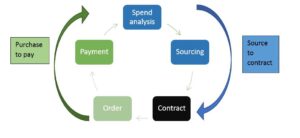I can bet every Procurement professional was in this problem. Every paper needs to be signed and then counter-signed. Every order needs the approval of 4 persons. While the production screams:
“You guys are so slow!!!”
And then, just as you manage to reduce this to an acceptable level, some random person in the organization finds a loophole and steals some materials or money.
Back to square 1….
Unfortunately, flexibility and control react exactly opposite to changes in the process. Our goal is to find the equilibrium, the “sweet spot”. A place where we have enough flexibility, and sufficient controls in place.

In my career, I had many discussions on the subject. Depending on who is on the other side of the table, you may get different opinions:
Audit: “Our controls are very week”
Finance: “We have no control over our spend if we do not approve everything”
Production:” We don’t care about your processes. Get us what we need, and get it now”
Sales: “We need to adapt fast and answer the customers’ demand, or otherwise we will lose the deal”
Making everyone happy seems to be Mission Impossible. Here are negotiation skills that can be very useful, plus some advice from my experience.
1. Do not bend the rules
We tend to react to the pressure from the stakeholders by breaking the rules. Cut the corner to get the thing done and that annoying manager off our back. And then audit comes. Unsurprisingly, no one comes to rescue, to declare that he was the one pushing for it. As a result, the process gets stricter, and we have just got another layer of approvals. I keep telling to everyone who complains about the process:
“The process must be followed. If it is a bad process, we can change it. No process is carved in stone.”
2. Data is your best friend
In meetings, stakeholders deal often with assumptions. And the only way to break this vicious cycle is to respond with data. It may be that your team is understaffed and simply not able to cope with the demand. But try to go to your boss and tell him that you have “a feeling that we need more people”. However, if you go in and state that each of your buyers processes 40 orders per day, plus spends daily 1 hour on mandatory reporting? Well, at least your chances are increased.
3.Determine the potential risk
Split your area of spend into groups that are similar. For example, into contracted, non-contracted, maverick. Or by product groups. And then create a risk matrix for the main steps (control points) in the process.
In case you do not know much about the risk matrix, here are a couple of useful links
https://i-sight.com/resources/risk-assessment-matrix/
https://miro.com/templates/risk-matrix
Your impact will be, of course, financial. Then brainstorm with your team what could happen if all controls have been removed? Imagine the worst-case scenarios. Soon you will see that in some processes control points are useless, while some points require even more control
4. Be transparent with all stakeholders
Sometimes your stakeholders do not know what is happening in the background. While your team is working hard on the request, no news is reaching them. And they get frustrated.
Explain the process, what needs to be done. Even if there is nothing really to share, as you are waiting for finance to get back to you with the budget approval. Don’t keep them in the dark.
5. Manage expectations
This can be seen as an extension to the previous point. I always try to give the estimated time in advance. The worst things happen when the sales promise to have something done based on their (wrong) estimation, and your vendor and production say it is not possible. In most cases, we just keep on pushing, in hope that the delay will be minor and acceptable. This is not a way to have satisfied stakeholders. As sooner than later, things may go out of your optimistic expectations. Guess who will get the blame? And you could avoid all this by giving the right information in the first place.
6. If nothing works, put them all together around one table
Processes affect all parties in the organization. Procurement processes are not separated from the rest. Sometimes it is best to put them all in one room. Let everyone explain their pain points, let the management understand the risk and potential opportunity cost related to a particular control. Ask everyone to come with real-life examples, instead of opinions. If the CFO hears that we lost a 100,000 deal because our approval process took 4 days, he will for sure become very vetted to make it faster.
A note for the end: Do not expect to get it right and keep it like this forever. Circumstance changes, markets change. And hence our processes will have to change again. It is a never-ending story. But using your experience and (hopefully) some of that advice, you will be well prepared for it.



